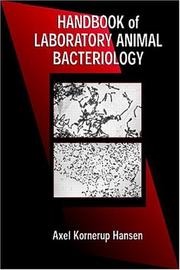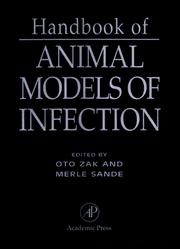| Listing 1 - 10 of 22 | << page >> |
Sort by
|

ISBN: 0849329132 Year: 1999 Publisher: Boca Raton (Fla.) : CRC press,
Abstract | Keywords | Export | Availability | Bookmark
 Loading...
Loading...Choose an application
- Reference Manager
- EndNote
- RefWorks (Direct export to RefWorks)
Laboratory animals --- Laboratory animals --- Veterinary bacteriology --- Diseases --- Diagnosis. --- Health. --- Technique.
Article
Abstract | Keywords | Export | Availability | Bookmark
 Loading...
Loading...Choose an application
- Reference Manager
- EndNote
- RefWorks (Direct export to RefWorks)
Animal. --- Animals. --- Laboratory animals. --- Laboratory-animals. --- Laboratory. --- Space.
Article
Year: 1999 Publisher: Madrid : Secala,
Abstract | Keywords | Export | Availability | Bookmark
 Loading...
Loading...Choose an application
- Reference Manager
- EndNote
- RefWorks (Direct export to RefWorks)
Animal. --- Animals. --- Assessment. --- Distress. --- Laboratory animals. --- Laboratory-animals. --- Laboratory. --- Pain. --- Research.
Dissertation
Year: 1999
Abstract | Keywords | Export | Availability | Bookmark
 Loading...
Loading...Choose an application
- Reference Manager
- EndNote
- RefWorks (Direct export to RefWorks)
Retroviridae --- Retroviridae --- Binding proteins --- Binding proteins --- monkeys --- monkeys --- Laboratory animals --- Laboratory animals --- Immunogenetics --- Immunogenetics --- Immune response --- Immune response
Periodical
Year: 1999 Publisher: [Glen Osmond, S. Aust?] Australian and New Zealand Council for the Care of Animals in Research and Teaching
Abstract | Keywords | Export | Availability | Bookmark
 Loading...
Loading...Choose an application
- Reference Manager
- EndNote
- RefWorks (Direct export to RefWorks)
Laboratory animals --- Animal welfare --- Animal experimentation --- Laboratory animals --- Animal welfare --- Animal experimentation --- Animaux de laboratoire --- Expérimentation animale --- Animaux de laboratoire --- Expérimentation animale --- Animal experimentation --- Animal welfare --- Laboratory animals --- Australia --- New Zealand
Periodical
Year: 1999 Publisher: [Glen Osmond, S. Aust?] Australian and New Zealand Council for the Care of Animals in Research and Teaching
Abstract | Keywords | Export | Availability | Bookmark
 Loading...
Loading...Choose an application
- Reference Manager
- EndNote
- RefWorks (Direct export to RefWorks)
Laboratory animals --- Animal welfare --- Animal experimentation --- Laboratory animals --- Animal welfare --- Animal experimentation --- Animaux de laboratoire --- Expérimentation animale --- Animaux de laboratoire --- Expérimentation animale --- Animal experimentation --- Animal welfare --- Laboratory animals --- Australia --- New Zealand
Article
Abstract | Keywords | Export | Availability | Bookmark
 Loading...
Loading...Choose an application
- Reference Manager
- EndNote
- RefWorks (Direct export to RefWorks)
Enrichment of the home cage may provide laboratory animals with an environment in which they can perform more species-specific behavior than in standard laboratory cages. Enrichment also often allows the animals more control over their environment, which may enhance their well-being. Evaluation of the effects of enrichment can be performed in different ways. An overview of the results of a series of experiments that evaluated environmental enrichment for laboratory mice are presented here. The experiments described in this paper have indicated that short- and long-term evaluation studies can be used for interpreting the impact of environmental enrichment on animals.
Animal. --- Animals. --- Behavior. --- Cage. --- Control. --- Enrichment. --- Environment. --- Environmental enrichment. --- Experiment. --- Experiments. --- Laboratory animals. --- Laboratory cages. --- Laboratory mice. --- Laboratory-animals. --- Laboratory. --- Long-term. --- Mice. --- Paper. --- Well-being.
Book
ISBN: 9282875229 Year: 1999 Publisher: Luxembourg Office for official publications of the European communities
Abstract | Keywords | Export | Availability | Bookmark
 Loading...
Loading...Choose an application
- Reference Manager
- EndNote
- RefWorks (Direct export to RefWorks)
Animal experimentation --- Laboratory animals --- Expérimentation animale --- Animaux de laboratoire --- Statistics. --- Statistiques --- Expérimentation animale
Article
Abstract | Keywords | Export | Availability | Bookmark
 Loading...
Loading...Choose an application
- Reference Manager
- EndNote
- RefWorks (Direct export to RefWorks)
Acoustic environment. --- Animal welfare. --- Animal. --- Environment. --- Laboratory animals. --- Laboratory. --- Noise. --- Sound levels. --- Sound. --- Survey.

ISBN: 9780127753904 0127753907 9781435699700 143569970X 9780080533551 0080533558 Year: 1999 Publisher: San Diego Academic Press
Abstract | Keywords | Export | Availability | Bookmark
 Loading...
Loading...Choose an application
- Reference Manager
- EndNote
- RefWorks (Direct export to RefWorks)
Handbook of Animal Models of Infection is a complete revision of a three-volume text that was published in 1986. It incorporates the major advances in the field during the past decade, in particular those concerning molecular biological procedures and new models that have been developed. It focuses on both methods and techniques, which makes it an essential and comprehensive reference as well as a benchtop manual. The Handbook will help investigators save time and effort in formulating an approach to test a new potential therapeutic agent or combination of agents for in vivo efficacy and to position the therapy for specific infections where it may have therapeutic promise. The book is divided into five sections; the first covering the general methodologies, followed by sections describing experimental bacterial, mycotic, parasitic, and viral infections. Key Features * Discusses ethical and safety aspects in an introductory background section * Covers principles of animal care and current techniques appropriate for the use of animal models of infection * Details a wide range of animals including rodents, rabbits, cats, and primates * Provides hands-on descriptions of how to set up the model * Discusses the major advantages and limitations of each model * Ensures full coverage of bacterial, fungal, viral, and parasitic infections.
Professional ethics. Deontology --- Bacterioses --- Mycoses --- Parasitoses --- Viroses --- Epidemiology --- infectious diseases --- Disease surveillance --- Models --- Laboratory animals
| Listing 1 - 10 of 22 | << page >> |
Sort by
|

 Search
Search Feedback
Feedback About UniCat
About UniCat  Help
Help News
News